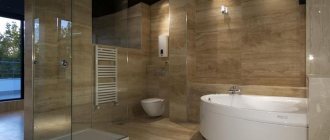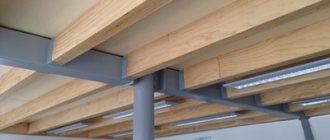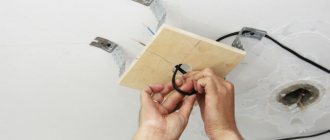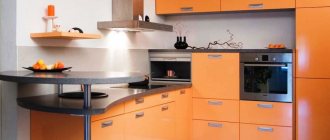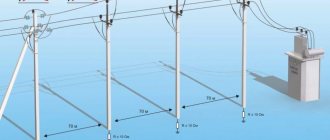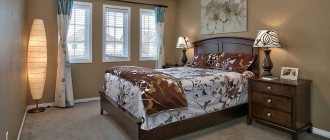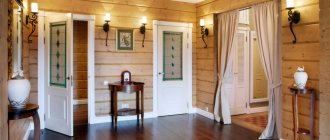Lighting plays an important role in the decor of a room. A correctly selected arrangement of lamps on a suspended ceiling or other decoration can transform a room beyond recognition; in a large hall, the space can be zoned, and a small area can be visually expanded. As an example, we will give several typical lamp placement schemes, and also present interesting design solutions for various types of premises. Since spot lighting (spots) is now popular in interior design, maximum attention is paid to it.
How to place lamps on a suspended ceiling correctly
Before deciding how to place spotlights, you need to choose the type of lamps and decide on their number. The most commonly used types are:
- incandescent lamps;
- energy saving (luminescent);
- LED designs.
The use of incandescent lamps is almost complete. They are too short-lived and get very hot. This is dangerous for the tension fabric and worsens the condition of the wiring around the cartridge. At the same time, the glow of these devices is most pleasant to the eye and gives a natural color perception.
Fluorescent lamps heat up less and have a much longer service life. The disadvantage is the unpleasant shade of the glow, as well as the presence of mercury vapor in the flask. This makes the use of such structures unsafe.
Spot ceiling lights based on LEDs are confidently leading among alternative options. They practically do not heat up, have a wide choice of colors, and have a maximum service life. Spot LED devices are the best choice for installation in a suspended ceiling, which is confirmed by operating practice.
The placement of lamps on the ceiling is determined by two criteria:
- decorative moment. The lamps form a certain pattern, a geometric figure;
- emphasis on certain areas of the room where it is important to ensure a given brightness.
The shade and power of LED lamps can be selected in accordance with the design intent. You can use many low-power spotlights, or install several brighter samples. It is necessary to strive for a uniform distribution of sources, although they are often guided by the interior features or the configuration of the room.
Calculation of the required number of lamps
The number of lamps is determined based on the overall level of illumination required for a given room. The main criterion is sanitary standards, which provide different values:
| An object | Illumination level, lux |
| Living room | 150 |
| Kitchen | 150 |
| Children's | 200 |
| Office, library | 300 |
| Corridor | 50 |
| Bathroom, bathroom | 50 |
Based on regulatory requirements, it is easy to calculate the optimal lighting level for each room. At the same time, you need to take into account your own preferences and decide on the most comfortable lighting style for yourself. Standards are not able to take into account the personal qualities of people, so they should be adjusted based on one’s own perception.
What parameters affect calculations
The main calculation criterion is the standard power of lamps per 1 m2 of area. It is generally accepted to be equal to 20 W, but this value applies only to incandescent lamps. LED devices have their own parameters, which are indicated on the packaging. To calculate the quantity, it is necessary to recalculate the total power of the devices in relation to the selected type of design. The performance of LED devices is approximately 7-9 times lower than that of incandescent lamps, so it is important to take into account the difference. Excessive lighting is poorly perceived by a person; harsh light negatively affects well-being and can cause headaches.
Optimal solutions
Stretch fabric has great decorative potential, which is realized with the help of lamps. There are many ideas for placing ceiling lighting fixtures. They are based on the uniformity of lighting, but take into account the features of the interior or the shape of the room. If there are decorative plasterboard structures, then the placement of lamps follows their shape, decorating and emphasizing the design elements.
Spot devices are installed around the perimeter of the room, or grouped in the center. In the latter case, the distance between them may be significantly less than the recommended values, but the overall brightness is compensated by a decrease in the power of individual point elements. A method of decorating a canvas that imitates a starry sky is often used, when the entire surface is filled in a chaotic manner with small lamps.
Important! It is most convenient to design a square ceiling, which allows you to create strict geometric groups. It is more difficult to choose a style in long and narrow rooms, when the distance between the long walls is small and greatly limits design possibilities. In such situations, additional elements installed on walls or other surfaces are used, and the ceiling slab is left free.
Before starting work, you should carefully consider and draw up a diagram of the location of point devices with the obligatory indication of the distances between them. This will help you find them after installing the tension fabric.
Some installation details
When installing spots, you should take into account the features of the ceiling covering. So, for example, if the building material used to finish the ceiling is flammable, then the following must be taken into account:
To wire lighting fixtures, you must use special heat-resistant wires.
- to carry out wiring for lighting fixtures, you must use special wires that are heat-resistant; the wiring connection when connecting spotlights must be reliable and insulated; the power of the lamps that are used must correspond to the technical characteristics of the wires, otherwise they will be subject to excessive overheating.
When choosing wires for connecting spotlights, you must be guided by the following criteria:
- they should not burn; they should be resistant to prolonged exposure to high temperatures.
These requirements are met by a cable in which the outer layer of the braid is made of fiberglass, and the internal insulation is made of high-strength organic rubber. These wires allow you to install a spotlight in rooms for any purpose, for example in kitchens, saunas, baths, bathrooms, as well as in unlimited quantities within reasonable limits.
To ensure reliable connection of wires during installation, you can use a special tool - a crimping press. It connects the cables using hollow copper sleeves, which serve as reliable insulation. An alternative to the press can be pliers, which are identical in principle to it.
Layout examples
The placement of lamps on a suspended ceiling largely depends on the purpose and shape of the room. The distances between point devices, decorative factors, and regulatory requirements are taken into account. It is important to ensure a harmonious combination of all norms and aesthetic needs, to create an attractive and stylish element of room decor. The space should not be overloaded with point light sources, but insufficient brightness is perceived negatively and depresses the people’s psyche. Let's look at some options:
Backlight lamps
When choosing the layout of ceiling spotlights, it is necessary to take into account not only the main light sources, but also the backlight. Although it plays a decorative role in the design of the room, it also makes its contribution to the lighting system.
Most often, neon, fluorescent lamps or LED strips are used for lighting. For any room, LED lighting is the best option.
Common problems and their solutions
The main problem that arises when choosing a layout is the lack of canvas area. The distances between elements become too small, causing sharp spots of light to form. They interfere with the correct perception of the design intent and irritate the visual organs. A ceiling with spotlights should be designed evenly, without excesses or empty areas. The solution to the problem is to use different types of lamps; in addition to point elements, you can add wall or hanging structures. If the distances between devices are too small, their power should be reduced. This will distribute the illumination more evenly and eliminate dark spots.
Important! Rooms that are too large require additional sources. They can be separate groups, or enhance the main lighting line. The main problem that should be solved in such situations is uniformity of distribution, reducing large distances between groups.
Cons of LEDs
- the need for reduced voltage, in particular 12 V and 24 V, which additionally requires converters;
- the most expensive light source;
- require free access for further maintenance and repairs.
But, despite these minor drawbacks, thanks to their fairly long operating period, which amounts to several tens of thousands of working hours, and significant energy savings, LED lamps are in high demand and fully pay for themselves.
If for some reason diode lighting equipment is not suitable for you, then you need to choose illuminators that provide for the installation of neon or fluorescent light sources. In this case, the majority of consumers prefer the second option, since they are quite simple to connect and maintain (you can install such devices yourself).
It is important to know! The main disadvantage of fluorescent sources is blinking and the supply of a cold light flux.
Illumination using neon sources is quite attractive, but installation of such illuminators is the most difficult, and you cannot do without a specialist.
Main conclusions
The choice of distance between ceiling lighting elements is determined not only by regulatory requirements, but also by your own preferences or design decisions. The main criterion for determining the optimal distance is also comfort, ease of perception, and the absence of irritating factors from an excess of lamps. When calculating the number of devices and determining the layout, you should take into account the purpose of the room, the age and habits of the people living in it. This will allow you to choose the optimal placement of lamps, install them at the most favorable distance from each other, and create an attractive and cozy design style for the stretched fabric.
Previous
Lighting in a suspended ceilingHow can you calculate how many lamps are needed in a room with a suspended ceiling
Next
Lighting in a suspended ceilingLighting options in a bedroom with a suspended ceiling
Device
Before installation, it is recommended to analyze two points:
- Lamp size. It is calculated depending on the object, the ceiling structure, the number of electrical appliances in the room, and the required power.
- Number of levels in the ceiling.
Pay attention to fire safety:
- non-flammable, heat-resistant cables;
- reliable connection method (via terminal blocks);
- correct determination of the required power.
Accenting with spotlights is a design move.
Next are the following stages of repair:
- Determining the type of ceiling. Rack and pinion - consists of a complex of narrow panels called slats and a hanging mechanism designed for fastening. Plasterboard - a lattice frame is folded, attached to the ceiling with connecting means. Tension - a canvas attached to a specific profile (made of aluminum or plastic) under the main ceiling.
- Designation and wiring in places previously marked on the plan.
- Ceiling installation.
- Cutting holes for spotlights of the required diameter using specialized tools.
- Connecting cables using terminal blocks. Finish the job with electrical tape or heat-insulating shrinkage.
- Fixing the device in a complete structure.
Depending on the design, two types of lamps are also distinguished.
Rotary
For rotating spotlights, the body together with the bulb can change the direction of light due to the presence of a hinge. This makes it possible to adjust the flow of “rays” to a certain place. These include:
- spots;
- chandeliers with rotating branches.
The standard rotary luminous apparatus includes:
- hinged part responsible for mobility;
- stationary element;
Attention! There is free space between the hinge and the stationary part, providing better ventilation.
- metal case with built-in base;
- bracket.
Rotating lamps - independent control of the flow of light.
Undeniable advantages (besides the obvious):
- various execution options;
- compactness of lamps;
- ease of installation;
- interaction with any light source.
There are no downsides as such. However, the cost makes itself felt.
Static
Fixed spotlights are designed for main (upper) lighting. They are used if the project does not provide for a central luminous element (chandelier or ceiling light). Then the points are located in groups on the main intersection areas.
Stationary lamps in the living room design
The device is firmly fixed in the ceiling space. Subsequently, the light flow is directed exclusively in one direction (mainly vertically).
They cost an order of magnitude cheaper than rotary ones. Which explains the lack of a turning mechanism.
